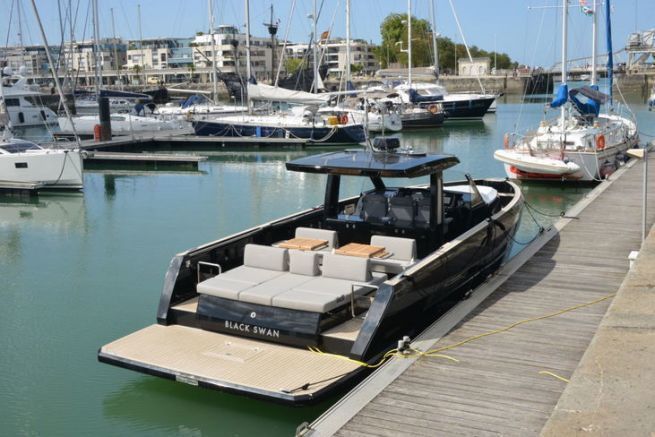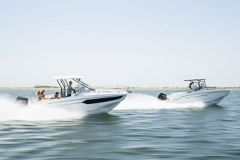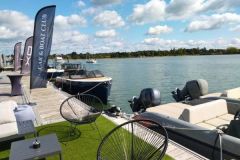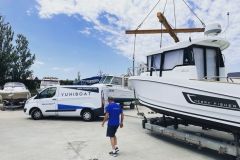Passing the boating license and getting permission to drive - that's the term - a powerboat is just the first step on a path that can take you far, far away. Or very close for that matter, there is no right or wrong option for boating, nor is there any more or less interest in going out to fish, water ski or just hang out. What matters, and will shape the rest of your skippering career, is the conditions of the first time you put your hand on the helm, alone. Follow these tips to make that first time memorable, fun and enjoyable.
Landlord or rental professional?
Two families of renters coexist. The individuals, owners of a boat and who want to take advantage of the time during which it is not exploited to put it at the disposal of the community. Often passionate, they can lack pedagogy in the handling but will be excellent advice to find navigation areas, tips or, on the return, to know in which restaurant to celebrate the first outing.
The rental professionals, on the other hand, will have a colder approach and will accompany you less far. They are pedagogical and are used to dealing with amateur beginners, so they will be able to give you a litany of the functioning of the rented boat. Do not ask them for more "personal" advice than that, it is not their job.
Finally, the platforms are excellent intermediaries between you and these two types of charter companies. They propose indistinctly - even if, often, a symbol allows to identify a "professional" renter - the boats coming from both types.
Search for the boat
Certainly, the search for the boat is the first step to take. We recommend you to be reasonable. You'll have plenty of time later to put yourself at the helm of a 40-meter, pardon 100-foot, long yacht!
To get started, take a boat under 10 meters and over 5 meters. Larger boats spend more time running around checking that "everything's running smoothly" than having fun. Smaller, you'll be shaken by the slightest swell or wake from another boat.
Insuring the boat
Opt for renting via a platform or a well established rental company. There are many of them and all of them offer insurance solutions to guarantee that in case of a problem, you will not have to pay the owner.
For that first rental, don't look at the insurance as a cost-saving measure. It is better to rent a smaller boat with better insurance than to take something more expensive and hope that everything will go well. Because, in reality, not everything goes well, it's almost impossible the first time.
Contact the owner
If you choose a platform, they usually allow you to get in touch with the owner before finalizing the rental. Get in touch with the owner of the boat you are considering renting and explain things clearly. Don't embellish or blacken things, all powerboat owners have started out at one time or another, and have asked themselves the same questions. And even if they haven't, that doesn't mean they don't make sense or aren't interesting. If you're wondering, it's because there's a need for someone to fill the gap.
Boaters like to talk to each other most of the time, especially about their boats. By being transparent about your status as a beginner who has never sailed, you will gain the trust of the person who is renting the boat he paid for, often at a high price, and for which he cares.
Meet the owner
If you have the possibility, suggest to the renter to meet him/her to discuss things in person. Face to face, the exchange is often more effective, because you will dare to say more than in writing. If the distance does not allow you to meet, at least phone and talk about your project, the boat, your status, the sailing area, the things to see... Once again, ask questions. What is the consumption of the boat? What are its defects? What are your defects?
It is during this exchange that you will take and give the essential element of trust. Do not hesitate to tell the owner that you will take the highest level of insurance during this rental. If necessary, see with your insurance company if an extension is possible. The idea is that everyone should be as reassured as possible.
Organize the outing
Once you have chosen your boat, you must now plan what you will do. For the first time, be modest and do not plan to actively sail for more than 2 hours the first time. Sailing a powerboat is physically and nervously exhausting. The approach of a new element, the risks ( real or imaginary ), the constant movement or the pressure not to damage the boat will make your stress level very high for this first time and you will leave the experience exhausted.
By means of the marine chart of the target area ( yours, not a friend's or the owner's ), aim for a navigation area compatible with this duration, thus located at 1 hour from the envisaged departure point.
Assuming that you only have a coastal license and that, for a first outing, you are limited to the 6-mile zone around a shelter. Assuming that the starting port will remain a good shelter, take a compass and form a circle around this starting point representing these 6 nautical miles.
It is thus in all this zone that you will be able to navigate, to stop... to take pleasure in this first exit.
Define, with the owner, the possibility that he accompanies you during this outing. Of course, it won't be the dream cruise, in the solitude of the sea wolf, but it will reassure everyone, especially you, to know that someone can take over if things get a little too complicated.
Which day to choose?
If the first reflex would be to rent during the weekend, it is probably not the right day for a first trip. Indeed, it is the day when you are likely to meet the most people at the departure and at the return. The pressure generated by both the fear of doing badly, of hitting another boat and the fear of being considered a beginner (which you are and which we all have been) will push you to make mistakes.
Actually, if the weather and your schedule allow it, opt for a Tuesday or Thursday. These are the slowest days on the water and often the days with the lowest rental rates.
As far as the weather is concerned, even if it is difficult to predict the weather for several weeks, favour an average weather, neither too hot nor too cold. No wind or rain would be an ideal, rarely reached at sea. This is one of the charms of boating: you never know what the weather will be like when you leave the dock!
Going alone the first time
Reservation made, itinerary defined and deposit paid, you go on the morning of the D-day to take this long awaited boat.
Go alone (or, gentlemen, go alone). If you go with your spouse, your children, friends ... in short, anyone who accompanies you will have advice to give you, whether or not they are competent in the subject. And inevitably, these advices will go against your decisions, hence an unnecessary stress and a probable argument that will tarnish this first day.
As captain, you will also have to take care of the safety of your crew, a responsibility that will take up time and energy, which you will no doubt lack in the first moments of piloting.
If you really want to take someone with you, offer to do it in two stages. First, you go out in the morning, for example, without the other person. Then you come back to the harbor and take them with you.
The morning of D-Day

On the morning of the first outing, do not eat too much. You might get seasick. But don't stay on an empty stomach either, hunger causes this discomfort.
Dress comfortably. You don't have to go to the hardware store to get the right look. A simple pair of denim pants or shorts - loose enough - and a t-shirt will do the trick. Don't forget to bring a cap and a fleece sweater, the temperature is always cooler on the water than on land. Take simple shoes, sports shoes or boat shoes bought in a sports store that you can easily take off your shoes will do. You are not looking for any kind of look, but for something practical and not afraid of anything, neither gasoline nor salt water, which we hope you will take!
On the way to the marina, stop at the bakery to buy some pastries for you and the boat owner. It's not mandatory, but it's a good way to start a positive exchange and break a seed in the morning.
Go around the boat
With the boat's owner by your side, take a complete tour of the boat, both inside and out. Don't hesitate to take note of anything that seems damaged, in bad condition or likely to break if you shake it too much. Because a boat on the water, it shakes, it hits and it vibrates. In other words, anything that is not (or poorly) fixed will inevitably fall at some point and, in its fall, may break.
A serious owner will willingly take note of all these points. Don't compromise ("I know it's broken, but since you're well insured, you might as well declare that it was you who broke it"). It is illegal on the one hand, and it only serves to increase the insurance premiums of all boaters on the other hand.
On the list of useful checks, fuel and water levels are often forgotten, which can lead to conflicts on the way back.
If the owner does not accompany you, agree on a time and place to return the boat. Make sure you have the same level of light as when you left, just to see the same things and nothing less or more than what you saw at the beginning.
Important point, you will probably not have the possibility to see the hull of the boat and will not be able to know the condition of it. Do not hesitate to note on the inventory of fixtures on departure " non-observable shell "to avoid a malicious landlord coming to accuse you of scrubbing!

Here we go
Put on your life jacket, turn on the kill switch and make sure the boat is in neutral. You are about to turn on the ignition.
Welcome to the small world of boating, have fun and enjoy this first outing. By the way, when you come across other boats, whatever their means of propulsion, give them a little wave, most of us will answer you!

















